How Food Price Spikes and Volatility Affect Poor Smallholders:
Evidence from Rural Tajikistan
Nonfarm income opportunities and livelihood options, as well as pro-poor agricultural growth, need to be supported and improved.
Note: This case study by Welthungerhilfe reflects the views of this organization. It is intended not to present research findings, but rather to show examples from their practical work and experiences in the field.
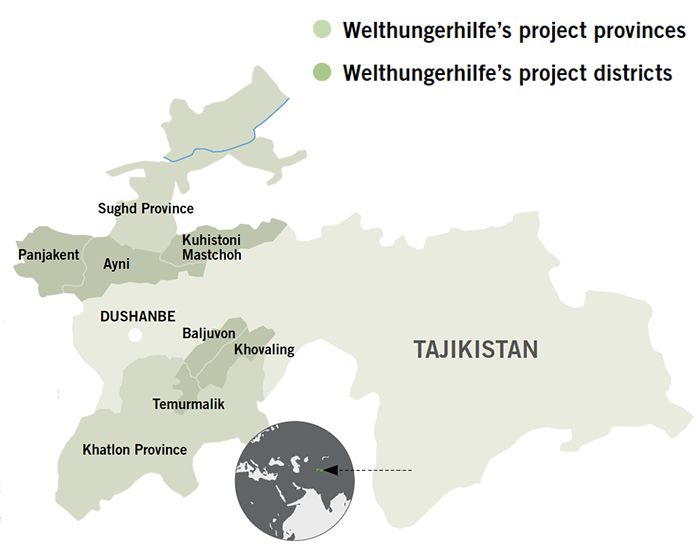
Shortly after global food prices reached a historic peak in February 2011, food prices in Tajikistan also climbed to record levels: In May 2011, prices were at their highest level since food-price monitoring started after the country’s civil war in the 1990s. The price of wheat – the country’s main staple food – increased by 60 to 70 percent compared with the same period a year before (WFP 2011). Wheat accounts for nearly three-fifths of total calorie intake in Tajikistan; bread is generally eaten at every meal.
The significant increase in food prices is not the only concern for many people in Tajikistan, the poorest and most food insecure of all the countries in the Commonwealth of Independent States (with a GHI score of 17.0, its hunger level is categorized as serious). Price fluctuations have also become more pronounced. Food-price monitoring data suggest that both the 2007–08 and the 2010–11 global food price crises were transmitted to the national level (see figure on page 37). However, in between the two crises prices in Tajikistan did not drop as international prices did.
The major reason for this global-to-national transmission is Tajikistan’s dependence on global food markets: the country imports about 58 percent of its food consumption requirements. The Russian Federation’s decision to place a ban on wheat exports in summer 2010 may have contributed indirectly to upward pressure on wheat price levels in Tajikistan. Although very little wheat was exported from Russia to Central Asian markets, in the months following the ban, prices for wheat in Kazakhstan – from which Tajikistan imports 90 percent of all imported wheat and flour – rose steeply.
Tajikistan’s vulnerability to world market prices is exacerbated by geopolitical factors. Because Tajikistan is landlocked, most goods must pass through neighbouring Uzbekistan. In spring 2011 political tension between the two countries increased, and rail tariffs for transit of Tajikistan cargos rose by 15 to 74 percent. Moreover, Tajikistan is dependent on petrol and diesel imports from Russia. Following Russia’s decision to impose export duties on top of increased tariffs for oil in June 2011, prices for fuel in Tajikistan reached record levels. When fuel prices are high, the inadequate infrastructure in this extremely mountainous country (more than half of the country lies higher than 3,000 meters) further increases transportation costs and consequently pushes up food prices.
In addition, market structures do not favor consumers; import markets for some food commodities, in particular wheat flour, are concentrated in the hands of a few large, influential firms, fostering the risk of price collusion (see, for example, WFP 2005).
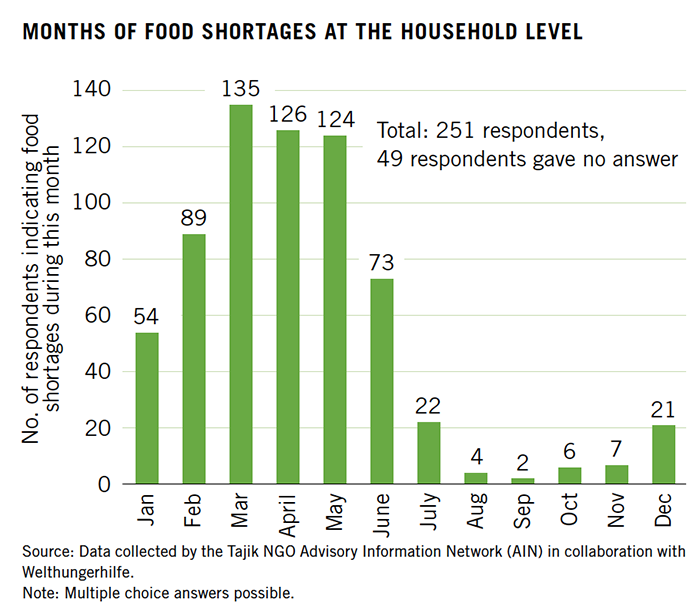

Odinamo Amirshojeva,
Dektur Village, Baljuvon, Tajikistan
Currently, the price for a [50-kilogram] bag of wheat at the bazaar is 120 to 130 somoni [US$26.50]; when the trader comes to our village the cost for one bag is 140 to 150 somoni [US$30.70]. He [the trader] says it is because fuel got so expensive.
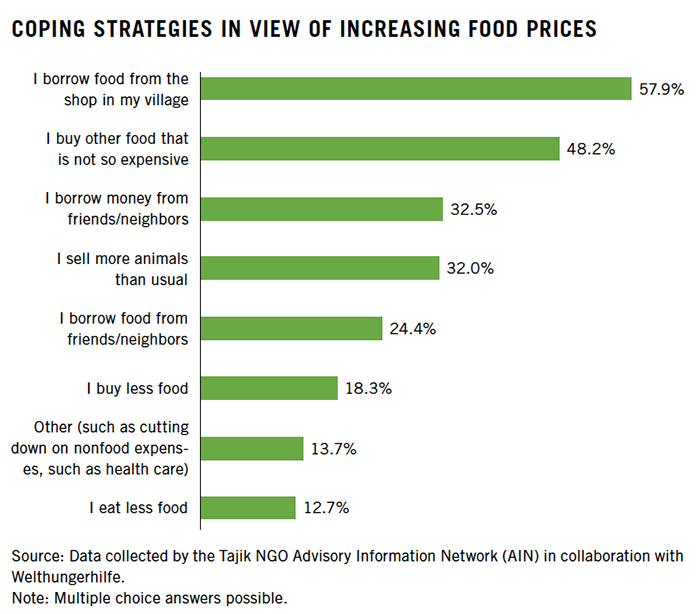

Malik Alimovich Zakirov,
Revomurtk Village, Kuhistoni Mastchoh, Sughd Province, Tajikistan
To curtail price spikes, it would be good if the government controlled the village shops. In the shop in our village, prices are still high even if prices at the bazaar in Khujand [closest city] have already been lower for a month. Prices in the village shop are much higher than at the bazaar. Bazaar means price control.
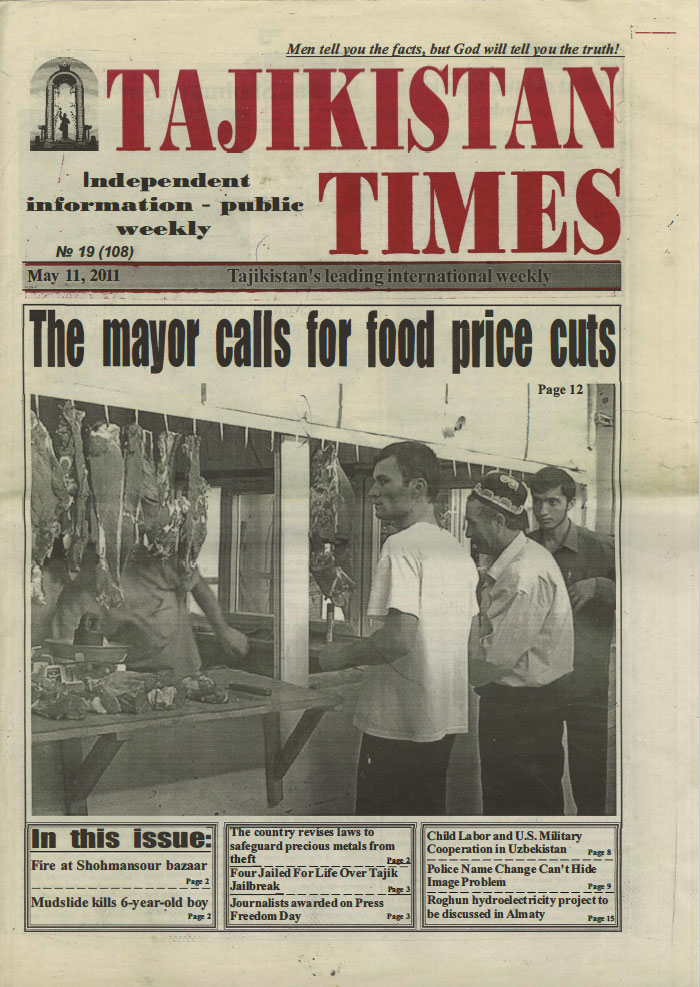 Skyrocketing food prices hit newspaper headlines in May and June 2011. To address people's growing anger, the office of the Dushanbe mayor set a cap on the prices market traders can charge for flour and meat.
Skyrocketing food prices hit newspaper headlines in May and June 2011. To address people's growing anger, the office of the Dushanbe mayor set a cap on the prices market traders can charge for flour and meat.
Rural Populations Suffer from Food Price Fluctuations
Compared with their urban counterparts, large segments of the rural population in developing countries are less integrated in day-to-day market dynamics. This is the case in Tajikistan, where many rural areas are remote and even inaccessible during certain periods of the year. In those areas, agriculture is the main source of income, and family farmers meet at least some of their consumption requirements through their own production. In many villages, bartering is common.
Wheat accounts for almost half of Tajikistan’s irrigated production and almost two-thirds of its rainfed production. However, the country’s prime irrigated land is devoted mostly to growing cotton, and nearly all smallholder wheat producers rely on rainfed cultivation. In May and June 2011 Welthungerhilfe asked 300 smallholder wheat farmers in the Khatlon region of south Tajikistan – the country’s leading wheat-producing area – two questions: Does the reduced level of market integration buffer the effects of food price spikes in the region? And, do increasing food prices represent challenges or opportunities?
Smallholder wheat farmers reported that price fluctuations are common and tend to follow a seasonal pattern: prices are usually lower during harvest time and increase during lean periods. Smaller spikes in prices were reported during festive seasons, such as Ramadan. Three-quarters of farmers stated that they had never before seen price increases similar to those experienced in spring 2011. Despite the commonality of upward and downward trends, smallholders are not necessarily well equipped to deal with such dramatic price movements as either producers or consumers of food.
As producers, most smallholders do not have the means to strategically interact with market dynamics. Some reportedly produce only for subsistence and rely on other sources for income, such as remittances, social transfer payments, irregular labour, or a combination of those sources. Farmers who do sell their produce enjoy only limited market access because of a lack of transportation, long distances, and inadequate infrastructure. Smallholders have very few potential buyers, restricting their bargaining power. Though farmers are usually well informed about market prices, half of all farmers reported that they often do not get a profitable sales price. One-third said they cannot negotiate over price at all.
Even though half of the smallholders reported having storage facilities, the vast majority said they sell their surplus produce soon after harvest to earn income, repay debts, and buy those foods they do not grow themselves (such as sugar and oil). At the time of the interviews, in May and June 2011, no farmer had remaining surplus stocks that could be sold for the record prices then prevailing.
Most of the farmers (83 percent) believed that commodity prices will remain high or increase further, but only a few smallholders (3.3 percent) saw this as an opportunity. By contrast, more than two-thirds disapproved of high prices. The most likely explanation for this response is that many smallholder wheat farmers are actually net consumers. Even record prices for wheat will not provide them with enough income to purchase other foods equally affected by price increases.
High Prices during the Lean Period Increase Burden on Net-Consuming Farm Households.
As consumers, farmers reported that even in periods of seasonal (“normal”) price volatility, they regularly experience food shortages. For many, the hungry period starts in February and March – when stocks are depleted – and ends with the new harvest at the end of June (see figure).
The 2011 food price escalation coincided with the lean period in rural Tajikistan. Poor rural households were hit particularly hard: more than half of all farmers stated that they had no more food in stock, nearly all households (94 percent) had exhausted their cash income, and more than half of all households had already acquired debts. In this situation, smallholders were forced to buy at record prices. In general, “increasing food prices” was the second most important reason given for current food insecurity at household levels (after “lack of money”).
Evidence suggests that food price increases in village shops and with mobile traders were even more pronounced than at the nearest bazaar. High fuel prices pushed up transportation costs and thus end-consumer prices in rural, often isolated, villages.
Farmers themselves identified “high transport/benzin costs” as one of the three main drivers of price increases. An almost equally high number, however, assumed that “traders’ collusions and monopolies” were behind the price bubble. Respondents saw greater regulation of traders as the most effective means of stabilizing prices.
Rural households Shift to Harmful Coping Strategies.
Smallholders already have strategies in place to cope with cyclic food shortages. In particular, seasonal job migration (predominantly to Russia) is common, and many households rely on remittances to support their food security. During the early 2011 food price spike however, households took further steps to tackle food shortages (see above).
Although delaying payment for food is not unusual, many smallholders reported that households’ debts increased as a result of higher food and fuel prices. This response is likely to further restrict their opportunities to participate in markets and reduce their resilience to future shocks. Worryingly, more than two-thirds of all farmers said that they expect the 2011 harvest to be worse than the year before (a “normal” year). In July 2011, the FAO/Ministry of Agriculture winter wheat crop assessment had not yet been released, but the 2010–11 wet season could be described as inadequate: Between September and June, the cumulative rainfall in Khatlon was 73 percent below the five-year average (FEWSNET 2011).
Other coping strategies, such as buying cheaper food, may have severe nutritional impacts, as seen in almost half of all farmers’ responses that their households had not consumed meat even once during the past week. A survey undertaken in selected districts of Khatlon and neighboring regions in March 2011 found that more than 40 percent of children were already showing signs of acute malnutrition (Walker and Lynch 2011).
National policy responses do not reach rural smallholders.
The findings of the interviews suggest that poor rural farm households will have little room to maneuver in working their way out of poverty and food insecurity. Given this picture, it will likely be difficult for most poor rural households to respond to the repeated appeal of Tajik President Emomali Rahmon to hoard basic food items for the next two years in the face of continued economic hardship (Central Asia Economy Newswire 2011).
In general, government efforts to tackle food price spikes and their impacts seem to have bypassed rural smallholders. In February 2011 the Tajik government decided to use its strategic grain reserves to temporarily reduce market grain prices by 15 percent. Ninety percent of all farmers interviewed had not heard about this initiative; only a dozen smallholders (4 percent) said they had benefited from it. The reserves were sold in major markets, and price relief could have trickled down to rural areas, but anecdotal evidence suggests that traders tend not to pass on lower urban prices to rural consumers.
In April 2011 the government released 3,000 metric tons of subsidized diesel fuel to buffer the effects of spiraling input costs. According to the Ministry of Economy, however, the fuel was intended not for local food growers, but for larger farms producing cotton for export. The Tajik government announced that it would set aside funds to help poor families cope with price inflation, but in July 2011 it was not yet clear who would actually benefit from such payments.
In May 2011 some city administrations set a cap on the prices market traders charge for flour and meat. Although some traders were detained for defying the instructions, other traders simply closed their businesses, saying the artificially low prices would leave them unable to cover their expenses, let alone make any profit. Apparently this policy of “subsidies without subsidies” served as a measure to influence public debate rather than addressing the reasons behind the drastic price increases.
The government’s stronger focus on the urban poor than on the rural poor may be explained by a perceived threat of destabilization stemming from metropolitan areas. On February 15, 2011, World Bank President Robert Zoellick stated that global food prices had reached “dangerous levels,” cautioning that this could negatively affect Central Asia: “[T]here is a real stress point that could have social and political implications” (Wroughton 2011).
In the medium to longer term, the recently approved Tajik food security law may redirect attention to local food producers. The law, adopted by Parliament in late December 2010, calls for reaching 80 percent self-sufficiency in food supplies. The adoption provides some indication of the government’s acknowledgment that it has only limited ability to withstand the pressure of increasing and volatile global food prices.
Welthungerhilfe’s Response: Reducing Vulnerability to Global Food Price Spikes by Supporting Sustainable Smallholder Agriculture and Fostering Nonfarm Income Opportunities in Rural Areas.
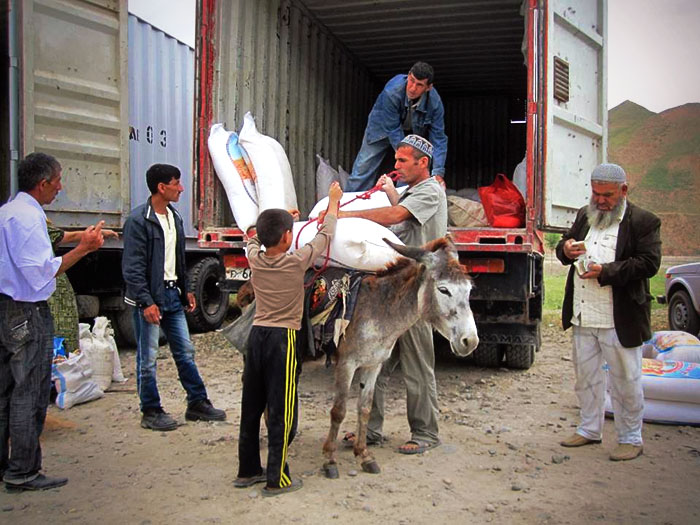 In Tajikistan’s rural areas wheat flour is usually sold in 50-kilogram bags. An average family of seven consumes approximately two bags of wheat flour in a month. Food price increases of 30 percent over six months have led to rising poverty levels. People can either buy wheat flour at the local bazaar for a slightly better price and arrange transport to their village or buy flour in the local village shop, where it is more expensive.
In Tajikistan’s rural areas wheat flour is usually sold in 50-kilogram bags. An average family of seven consumes approximately two bags of wheat flour in a month. Food price increases of 30 percent over six months have led to rising poverty levels. People can either buy wheat flour at the local bazaar for a slightly better price and arrange transport to their village or buy flour in the local village shop, where it is more expensive.
The recent food price spike in Tajikistan occurred against a background of multiple existing vulnerabilities. Economic hardship and erratic weather had already threatened smallholders’ production capacities and access to adequate food, and climate change is expected to exacerbate the challenges faced by poor food producers.
The many production constraints confronted by rural households in Tajikistan are coupled with a lack of knowledge about sustainable methods of land use and cost-effective means to increase yields. Tapping the potential of rural smallholders can reduce the vulnerabilities of poor farm households while raising the supply of food in local markets, improving incomes, and driving wider rural development.
Welthungerhilfe is working with farmers in the Khatlon and Sughd Provinces to help them increase agricultural production in ways that are sustainable and resilient to climate change, through measures such as soil protection practices, crop rotation, limited plowing, and more efficient water use. Welthungerhilfe also supports farmer associations to improve farmers’ access to inputs and foster the exchange of newly acquired knowledge. A special focus is put on low-cost approaches to allow easy replication of measures. In recent years Welthungerhilfe’s various projects in the Khatlon Province have increased agricultural productivity by up to 50 percent (depending on the measures applied, but especially through the combination of high-quality seeds and organic manure). These projects have also decreased the livelihood expenditures of the targeted rural households in the region by up to 30 percent through energy-saving measures.
But there are limitations to agriculture in Tajikistan: Only about 7 percent of Tajikistan’s land base is arable. The country already has one of the highest population density levels in the world, with an average of 0.14 hectare of arable land per person. Clearly, more diverse livelihood opportunities are needed in rural areas. To promote the creation of nonfarm income opportunities, in 2007 Welthungerhilfe began supporting the emerging tourism sector, which has considerable potential.
Currently, Welthungerhilfe is engaged in revitalizing community-based systems of eco- and agrotourism in the Zerafshan Valley (www.ztda-tourism.tj/en). As a first step, a network of community-based service providers was established. Today, the project mainly aims to improve service quality in tourism. These activities are part of a larger effort of Welthungerhilfe, the European Center for Eco- and Agro-Tourism, and the Aga Khan Foundation to boost tourism in Tajikistan as a whole. Ultimately, the project Strengthening Tourism Business for Sustainable Development in Tajikistan expects to generate higher revenues for inhabitants of rural and mountainous areas and to lead to the adoption of tourism practices that combine economic, social, and environmental sustainability.
Some of the service providers who received start-up assistance (for example, homestay owners, guides, drivers, cooks, and porters) generated additional income of up to €1,800 (about US$2,500) in 2010, making them less dependent on income from agriculture and less vulnerable to economic or weather-related shocks.
In view of widespread food insecurity in rural areas, the anticipated effects of climate change, and continuing high rates of population growth, it is important not only to support smallholder agriculture to achieve sustainable production gains, but also to create further nonfarm income opportunities.
Footnotes
- A recent study suggests that market concentration is less apparent today than it was a few years ago. It is argued that higher volatility in the markets during the past several years seems to have resulted in more traders hoping to earn a profit from wheat (Chabot and Tondel 2011).
- The interviews were conducted by the Tajik nongovernmental organization Advisory Information Network among randomly selected wheat-producing households in three districts of Khatlon Province (Baljuvon, Temurmalik, and Vakhsh). Interviews were conducted in all villages of the selected districts proportionally to the size of the village.